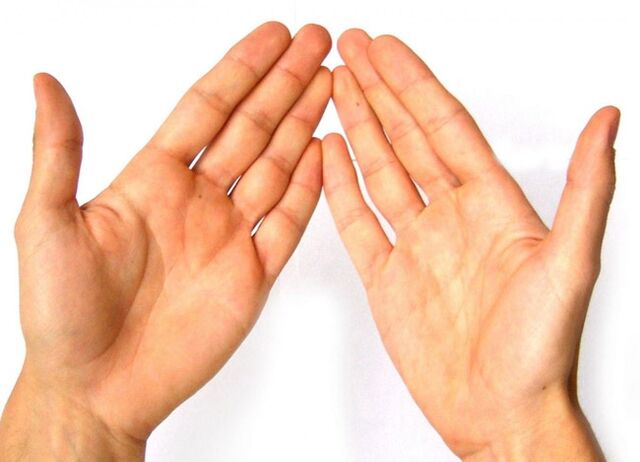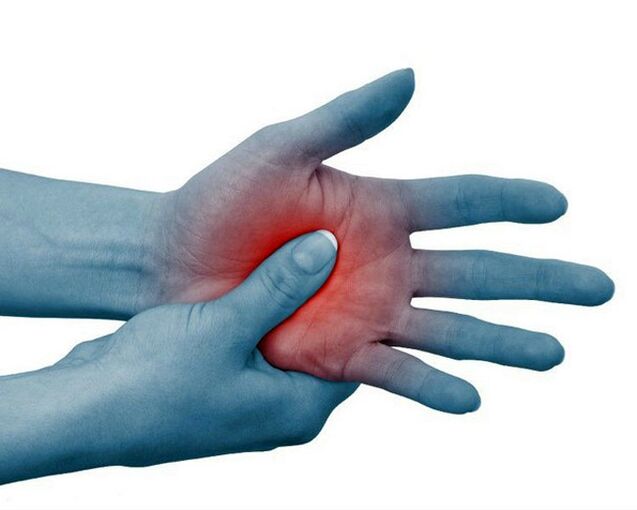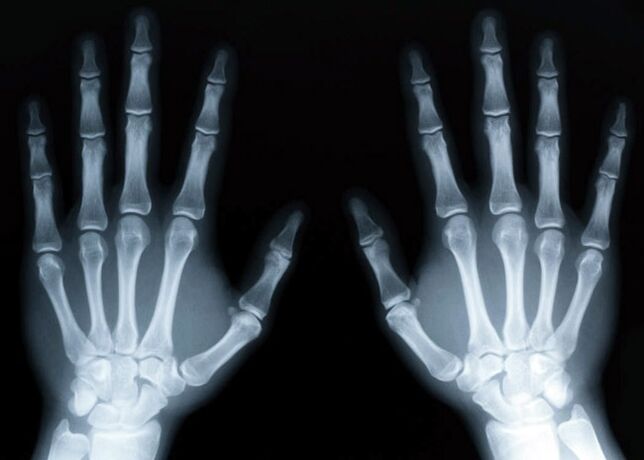Patients often complain that the joints of the fingers hurt. Each pathology has pronounced symptoms, so the specialist quickly diagnoses and prescribes the appropriate treatment.
Rheumatoid arthritis
Rheumatoid arthritis is a serious disease accompanied by an inflammatory process. It causes pain in the joints and their deformation. The pathology usually occurs in people over 30 years of age. Women suffer from it three times more often than men.

Rheumatoid arthritis comes on suddenly and is associated with impaired immune system function. In this disease, the immune cells mistake the joint cells for viruses or bacteria and try to eliminate them. The decay process can take years.
We distinguish the following symptoms of the disease:
- severe joint pain that worsens at night or in the morning;
- stiffness of joints after sleep;
- high body temperature;
- sleep disorder;
- rapid fatigue;
- decreased appetite;
- sudden weight loss;
- formation of lumps in the elbow area.
Rheumatoid arthritis develops as a result of the following factors:
- previous sore throat or flu;
- joint injuries;
- infectious pathology;
- long-term stress and depression;
- genetic predisposition.
A distinctive feature of rheumatoid arthritis from arthrosis is the reduction of pain during exercise. If the joints of the fingers of the right hand are painful and swollen, then the same symptoms appear on the left hand. Over time, the disease can also affect other joints.

If you start therapy at an early stage, you can avoid deformation and destruction of the joints.
Shade!Breastfeeding for two years halves the risk of rheumatoid arthritis in women.
Treatment
Modern treatment methods for rheumatoid arthritis include:
- aurotherapy;
- cytostatics;
- taking antimalarial drugs;
- sulfonamides;
- D-penicillamine.
On average, even an experienced rheumatologist takes about 6 months to choose the right treatment method, as he examines the patient's characteristics and drug tolerance.
What is aurotherapy?
Aurotherapy involves taking medicines containing gold salts.
Doctors recommend the use of gold preparations in the initial stages of the disease. With their help, a positive effect can be achieved in the treatment of acute, rapidly developing pathology, with severe pain and early degenerative changes in the joints. Gold-based drugs are prescribed to patients in cases where non-steroidal anti-inflammatory drugs have not alleviated their condition.
The main advantage of aurotherapy is that it can be used in the presence of simultaneous inflammatory pathologies and malignant tumors. During the research, scientists also found that gold salts actively fight against fungi and some bacteria, including Helicobacter pylori.
The duration of treatment with gold products is 2-3 months. If the patient's condition has not improved during this period, then this technique is canceled.
Note!Many people experience a relapse of rheumatoid arthritis some time after gold treatment. The rheumatologist can prescribe aurotherapy again. Sometimes such treatment can last for years if there are no negative consequences for other organs.
Is cytostatic treatment effective?
Cytostatics are usually used to eliminate the symptoms of rheumatoid arthritis.
Since the disease is autoimmune in origin, it is not surprising that doctors prescribe immunosuppressants. Their main advantage is their high efficiency at a relatively low dose. Rheumatoid arthritis patients are prescribed 5 times or even 20 times less doses of cytostatics than cancer patients. Medicines have proven themselves in the fight against severe forms of the disease with a high degree of progression.
Another advantage of immunosuppressant treatment is the minimal number of side effects. Rarely, patients complain of the following symptoms:
- skin rash;
- bowel dysfunction;
- chills;
- difficulty urinating.
If the drug is stopped or the doctor changes the dose, the side effects disappear quickly. The duration of the treatment is 1 month.
Treatment of finger joints with antimalarial drugs
Treatment of rheumatoid arthritis with antimalarial drugs is extremely rare. The main advantage of this treatment is the good tolerability of the drugs. A significant disadvantage of this treatment is that the antimalarial drugs work slowly. Their effect is noticeable after 6-12 months, but the therapeutic effect is rather weak.
Do sulfonamides help rheumatoid arthritis?
Drugs belonging to the sulfonamide group are successfully used to treat finger pain. Their advantages are:
- Good tolerance.
- Low-grade complications, if any.
- At an affordable price.
The disadvantage of these drugs is the slow effect. The positive effect can be noticed only 3 months after the start of therapy.
How to treat the disease with D-penicillamine?
If the patient is suitable for treatment with gold preparations or the use of cytostatics, it is not necessary to prescribe D-penicillamine. In terms of its effectiveness, it is far inferior to the listed treatment methods, but it significantly exceeds them in terms of the number of side effects, their frequency of occurrence and the extent of complications. Therefore, D-penicillamine treatment is used in cases where patients do not tolerate gold salts and cytostatics well.
D-penicillamine is used effectively in patients with heart, respiratory or kidney complications. You have to take it for 3-5 years, then take a break for several years, then repeat the course.
Gout - symptoms and treatment
One of the dangerous diseases of the joints and tissues is gout. It occurs due to a metabolic disorder of the body. Gout is characterized by an increased amount of uric acid in the lymphatic system.
Symptoms of the disease are as follows:
- inflammation of the big toe joint;
- severe pressing pain in the morning or evening;
- increased body temperature;
- skin redness;
- growths on the legs or arms.
If treatment is not started immediately, the patient may develop gouty arthritis. Possible complications include urolithiasis and kidney failure, which can lead to death.

Nonsteroidal anti-inflammatory drugs are used to treat gout for 1-2 weeks.
In order to quickly reduce the concentration of uric acid in the body, anti-gout drugs are prescribed.
To eliminate the acute symptoms of gout, experts prescribe a medicine based on the alkaloid of the tubers of the wonderful lily family. Glucocorticoids are used to reduce swelling and pain. These drugs quickly remove inflammation, but have a negative effect on the immune system.
Psoriatic arthritis
About 15% of patients diagnosed with psoriasis have problems with the joints of the fingers. The signs of this disease are as follows:
- joint deformation;
- pain syndrome at night;
- numbness of the limbs;
- burgundy discoloration of the skin at the site of the disease;
- finger swelling;
- limited mobility.
Most patients with psoriatic arthritis experience damage to the nail plates. First, small pits form on their surface, and then their color changes due to disruption of microcirculation.
Quite often, pregnant women are diagnosed with psoriatic arthritis. This is due to the fact that the disease is also hormonal, and a woman undergoes hormonal changes in her body during pregnancy. Increased signs of arthritis in pregnant women are often associated with weight gain.
The following causes of psoriatic arthritis are identified:
- injuries;
- severe stress and emotional stress;
- excessive physical activity;
- infectious diseases;
- hereditary tendency.
The following groups of drugs are used to treat psoriatic arthritis:
- Non-steroidal drugs. Designed to eliminate inflammation and reduce pain.
- Glucocorticosteroids: injected into the joint cavity.
- Cytostatic from the group of folic acid antagonists: the most popular systemic drug.
- Immunosuppressant that selectively acts on T-lymphocytes: it is used to slow down the changes occurring in bone and cartilage tissues.
In the case of psoriatic arthritis, it is recommended to avoid alcoholic beverages, reduce consumption of citrus fruits and smoked foods, and follow a low-calorie diet.
Osteoarthritis - how to treat it and what are the consequences of the disease?
Elderly people often complain that their finger joints are swollen. This can be a symptom of osteoarthritis. The disease can occur for the following reasons:
- hormonal imbalance;
- genetic predisposition;
- occupational stress and injuries;
- age-related metabolic disorder.
Joint pain can help identify the disease. The specialist makes the exact diagnosis after X-ray examination and MRI.
Exercise helps alleviate the patient's condition. The series of exercises is selected by the doctor, focusing on the individual characteristics of the patient with osteoarthritis. Therapy also includes following a diet to lose excess weight, if any. You cannot do without thermal procedures. We recommend the paraffin bath, to which mineral oil must be added.
Nonsteroidal anti-inflammatory drugs from the group of propionic acid derivatives and acetylsalicylic acid are prescribed to eliminate pain and reduce swelling. Among the pain relievers, a drug belonging to the anilide group is often used. Massages warm up the muscles and improve blood circulation.
If treatment is not started in time, the person will be unable to cope with their daily activities in the future. In such cases, joint replacement surgery cannot be avoided.
What is rhizarthrosis?
If the patient has pain in the thumb, this may indicate that he is suffering from rhizarthrosis. The reasons for this phenomenon may be:
- joint overload;
- previous infectious disease;
- injuries;
- body poisoning.
Treatment of rhizarthrosis in stage 1-2 includes taking chondroprotectors. They activate the process of the appearance of new cartilage cells, which helps to eliminate the disease.
The use of manual therapy for the treatment of rhizarthrosis is very popular. The therapist can re-adjust the altered joint, as a result of which the pain syndrome ceases. In addition, by massaging the thumb, you can increase the tone of the cartilage tissue and improve the mobility of the joints.

If the patient is diagnosed with stage 3 rhizarthrosis, intra-articular injections of hyaluronic acid are prescribed. The use of glucocorticosteroids and non-steroidal anti-inflammatory drugs is also effective. They increase blood flow in the affected joint, eliminate pain and reduce swelling.
A traditional remedy for pain in the fingers
You can cope with pain not only with medicines, but also with folk remedies. In case of acute pain, the use of a gauze bandage soaked in apple cider vinegar is effective. A poultice made with fried onions or boiled potatoes is perfect for reducing swelling. It is useful to warm the painful joint with hot sea salt and rub it with pine oil.
Tinctures
One common treatment method is tinctures. You can use vodka to make it. Take 50 ml of vodka and 30 ml of valerian tincture, mix both components and add a few pods of red pepper. After 3 hours, moisten a cotton ball in the resulting mixture and apply it to the phalanx. The positive effect is noticeable after one month of treatment.
Another effective remedy is a tincture based on chestnut flowers. It is enough to collect the ingredients and mix them with vodka. Leave for 14-20 days. Rub the product in when your fingers feel numb and painful. The use of lilac instead of chestnut flowers is allowed.
Ointments
If your joints hurt when you squeeze your fingers, use an ointment made of mustard and honey. To prepare, mix 5 g of mustard and 15 g of honey. Then add 30 ml of olive oil, steam the mixture in a water bath to a thick consistency, cool and use daily to treat the affected joints.
An ointment based on bay leaves and juniper needles is recommended for pain in the joint of the index finger of the right hand. Both components must be mixed in equal proportions, then add 50 g of butter. You can use the ointment during regular joint massage.


























